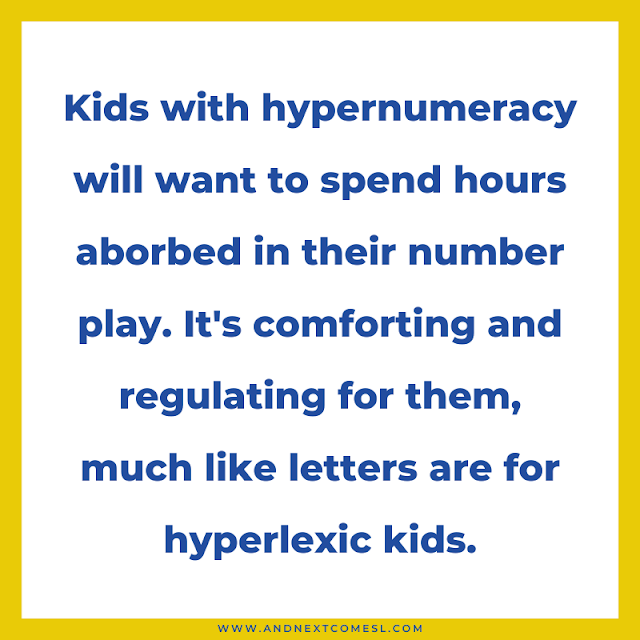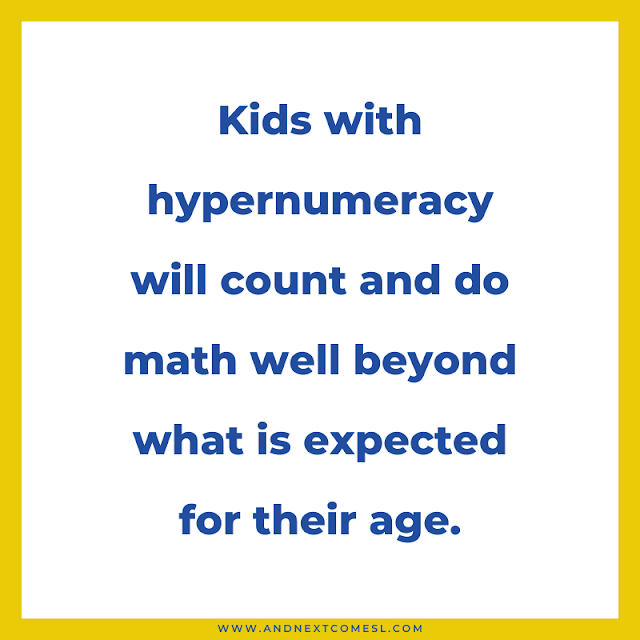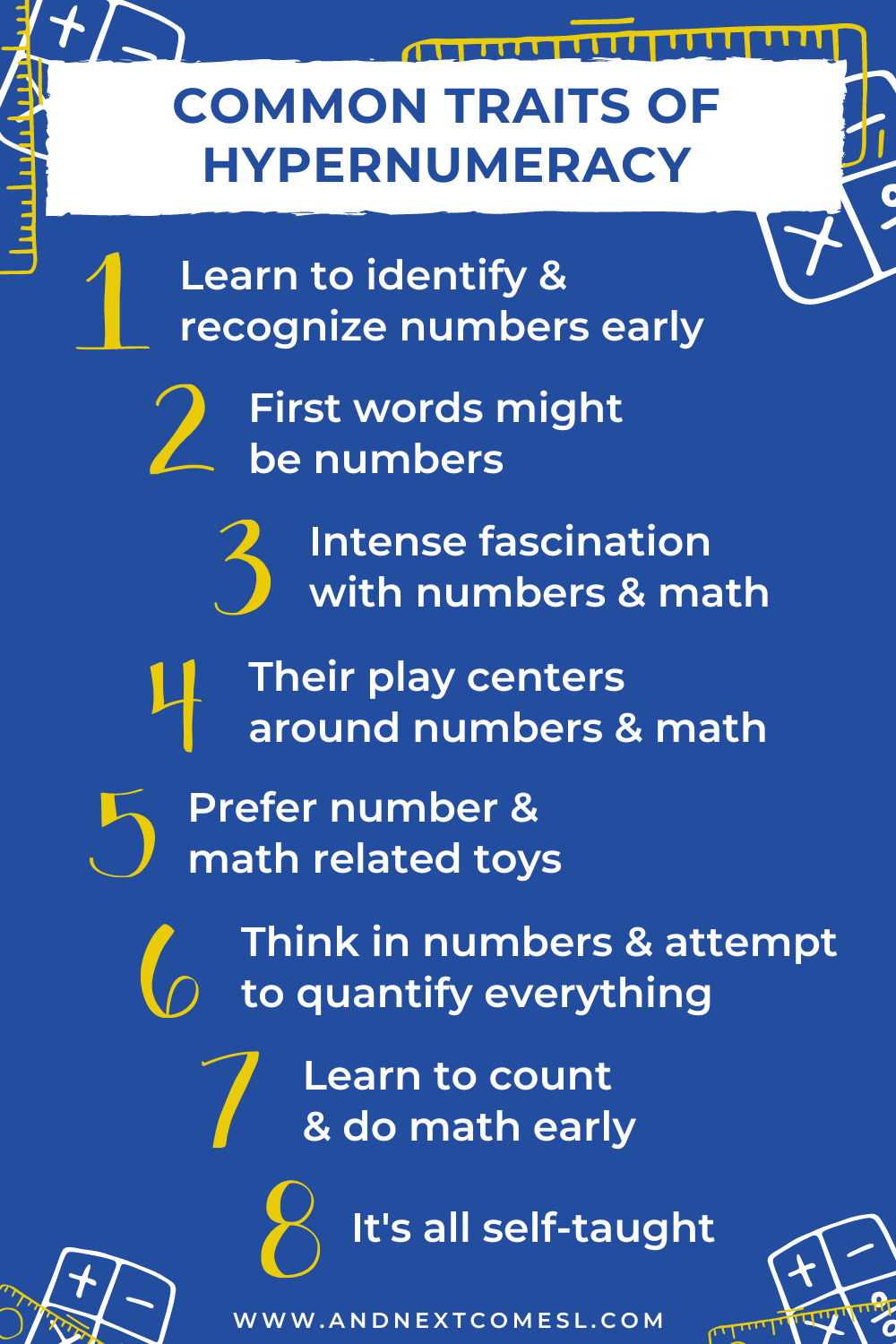For many hyperlexic kids, numbers and math quickly overtake letters and reading to become the main passion or interest. That was the case for my son. And it seems to be the case for a lot of other hyperlexic kids.
Well, that's where hypernumeracy comes in.
It's something my son was identified with during his autism assessment back in November 2014, but could I find much info on it? Nope. There were 63 search results on Google that day I first googled it. Sixty-three!
When talking about hypernumeracy, I have to draw on personal experience, the stories that families have shared with me over the years, and the hyperlexia research as best I can. Because, unfortunately, there isn't any information or research to work with on this particular topic.
Below you will find a list of common traits of hypernumeracy to give you a better understanding of what hypernumeracy is and what it looks like. I've also sprinkled in some stories from our own life as examples.
The Most Common Traits of Hypernumeracy
Now, before we dig in, please keep in mind that this list of traits are based on our personal experience and those that have been shared with me over the years by other families.
They are also based on and adapted from common hyperlexic traits since hyperlexia and hypernumeracy are related and go hand-in-hand. Although, please note that not all hyperlexic kids will have hypernumeracy.
Also, remember that hypernumeracy isn't an official diagnosis or anything. It's not like you'll find it in the DSM. There also isn't a lot written about it. That means no official list of characteristics can be easily found.
**So please remember that this list of traits of hypernumeracy is by no means official. Nor should it be used to "diagnose" hypernumeracy.**
1. Learn to identify and recognize numbers early
First things first, kids with hypernumeracy learn to identify and recognize numbers quite early. Often in or around the same time that hyperlexic kids learn to identify and recognize letters. So usually that is somewhere between 18-24 months of age.
Usually kids with hypernumeracy learn numbers concurrently with letters. However, more often than not these kids start off with letters and then quickly move to numbers.
2. First words might be numbers
Don't be surprised if their first words are numbers, similar to how the first words for many hyperlexic kids are letters (see early signs of hyperlexia here).
You might also notice that their vocabulary may continue to be dominated by number or math related words going forward.
3. Intense fascination with numbers and math
For hyperlexic kids, it's all about letters. But, for kids with hypernumeracy, numbers and math quickly become their everything. This interest in numbers quickly overtakes their interest in letters and is very intense.
Kids with hypernumeracy seek out numbers everywhere, much like hyperlexic kids do with print and written words.
They are drawn to anything involving numbers and math such as clocks, timers, thermostats, the depth of the swimming pool, the speed you are driving (and the fact that you're going over the speed limit..), etc.
They might point out numbers everywhere they go. For instance, did you know that lamp posts have numbers? I did not until my son pointed them out.
They might be more interested in the number of pages or chapters than the book itself. Or maybe they'll add page numbers to each page in blank notebooks instead of filling the page with drawings or stories like their peers might do.
It's just all about numbers for them 24/7.
As we'll touch on in the next couple of sections, their play centers around numbers, they think in terms of numbers, they quantify EVERYTHING, and their preferred toys are usually number or math related. And probably none of this is surprising to you.
4. Their play centers around numbers and math
Similar to how hyperlexic kids spend hours playing with letter toys, singing the ABCs, and reading, kids with hypernumeracy opt for playing with numbers, counting, writing numbers or math equations, studying clocks, playing with calculators, and so on.
Basically, if it involves numbers, they'll be drawn to it. Seriously, who's idea was it to put a chair under a thermostat in the waiting room of the childhood development center? Because I'd like to have a word with them...
Anyway, kids with hypernumeracy will want to spend hours absorbed in their number play. It's comforting and regulating for them, much like letters are for hyperlexic kids.
As they get older, their play might involve writing numbers with chalk, doing dot-to-dots, playing sudoku, playing with dice, doing math equations or workbooks for fun, and so on. As a teenager, for example, my son spends hours doing nonograms, which are logic puzzles involving numbers.
5. Prefer number and math related toys
Number magnets, number puzzles, calculators, rulers, measuring tapes, dice, telephones...anything with numbers and they'll love it!
For instance, my son's favorite thing to play with as a toddler were these giant foam numbers that I made him. He would literally spend hours counting up and down with them, sometimes one by one, but usually skip counting by different numbers. He'd make math equations with them and so on.
We also carried calculators (yes, plural!) with us everywhere we went because calculators were another favorite toy for him. They are still one of his favorite possessions even as a teenager.
6. Think in numbers and quantify everything
To me, this trait is the most important one. Literally everything is thought about in terms of numbers, math, or measurement. They attempt to quantify everything.
For instance, they might refer to movies by their run times instead of their titles. They might refer to grandma's house as "488 house" because that's grandma's house number. They might refer to your car by the license plate number. They might point out that all four seasons have exactly 6 letters in them (spring, summer, autumn, winter). I could go on and on with examples...
7. Learn to count and do math early
I mentioned the early counting trait on the list of signs of hyperlexia in toddlers and babies. By the way, we're not talking about counting to ten here. We're talking large numbers and skip counting early. Stuff you don't expect a two year old to do.
However, kids with hypernumeracy go a step further than just learning to count. They start to do math early as well, which can range in abilities from multiplying/dividing, exploring fractions, learning about prime numbers, exploring complex shapes, and more.
The point here is that they'll count and do math well beyond what is expected for their age. And when I say well beyond, I mean well beyond...
Similar to hyperlexia where the advanced reading skills are apparent before age 5, the precocious math skills are apparent quite early in kids with hypernumeracy as well. You might notice these advanced skills at age 5 or 4 or 3 or 2...For us, it was around age two.
But most importantly, these skills are all self-taught, which leads me to my next point.
8. It's all self-taught
This trait is also an important one. We didn't drill them with flashcards or teach them how to do math. These kids simply pick up on it all on their own. It's all self-taught, just like the precocious reading ability in hyperlexia is. Math just comes easy to them.
A Summary of Hypernumeracy Traits
Whether you're a skim reader or you read everything above, here's a quick recap of all the unofficial traits of hypernumeracy that were discussed above:
- They learn to identify and recognize numbers early
- Their first words might be numbers
- They have an intense fascination with numbers and math
- Their play centers around numbers and math
- They prefer number and math related toys
- They think in numbers and quantify everything
- They learn to count and do math early
- It's all self-taught









